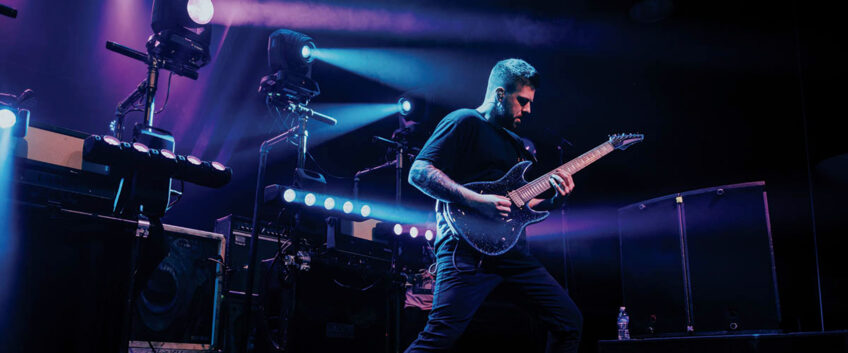
The rise of 7 and 8-string guitars: versatility and power
- dream_theater-the_mirror-extract.gp
- korn-freak_on_a_leash-msmt-extract-2.gp
- muse-supremacy-extract.gp
- slipknot-the_devil_in_i-extract.gp
- meshuggah-demiurge-extract.gp
- babymetal-karate-extract.gp
- george_van_eps-prelude_to_a_kiss-extract.gp
Since its inception, the history of the 7-string guitar has been marked by continuous development, peaking in the modern era, especially within the metal community. From the 1980s, this instrument saw a notable rise in popularity, attracting virtuosos seeking added expressiveness and sonic depth.
Well before the advent of modern metal, this instrument established its relevance across eras. Initially designed to enhance harmonies in Jazz and classical music, its capability to integrate bass lines directly into the guitarist’s play captivated a wide range of performers. This versatility elevated the 7-string guitar to a preferred choice among seasoned musicians and professionals across various musical genres, offering a refreshed perspective on guitar artistry.

Toward the late 1990s, a pivotal period began, seeing a growing interest in 7-string guitars within specific genres such as Nu-Metal, Progressive Metal, and Djent. This revival was fueled by the desire to expand the realm of musical possibilities and to push innovation further with an instrument that is both robust and versatile.
The adoption of the 7-string guitar by these metal icons, coupled with technical additions such as the expansion of tuning ranges, solidified its place in the music industry. Tuning options, ranging from B standard to Drop A, and even to Drop E, have opened doors for artists to deep and dark sonic explorations, thus defining the sonic identity of many metal bands and other musicians from the 1990s to the present day.
What are the origins and evolution of the 7-string guitar?

From the 15th to the 18th century, the guitar evolved from 4-5 to 6 strings, then adopted metal strings around 1800 for more volume. In the 19th century, Russia popularized the 7-string guitar, tuned differently and inspired by other instruments. This version gained popularity in Brazil for choro and samba, adopting nylon strings in the 1980s. Concurrently, in the 1930s, George Van Eps played a key role in the development of the 7-string electric guitar in jazz, in collaboration with Epiphone, marking its integration into Western music.
The Renaissance of the 7-String Guitar
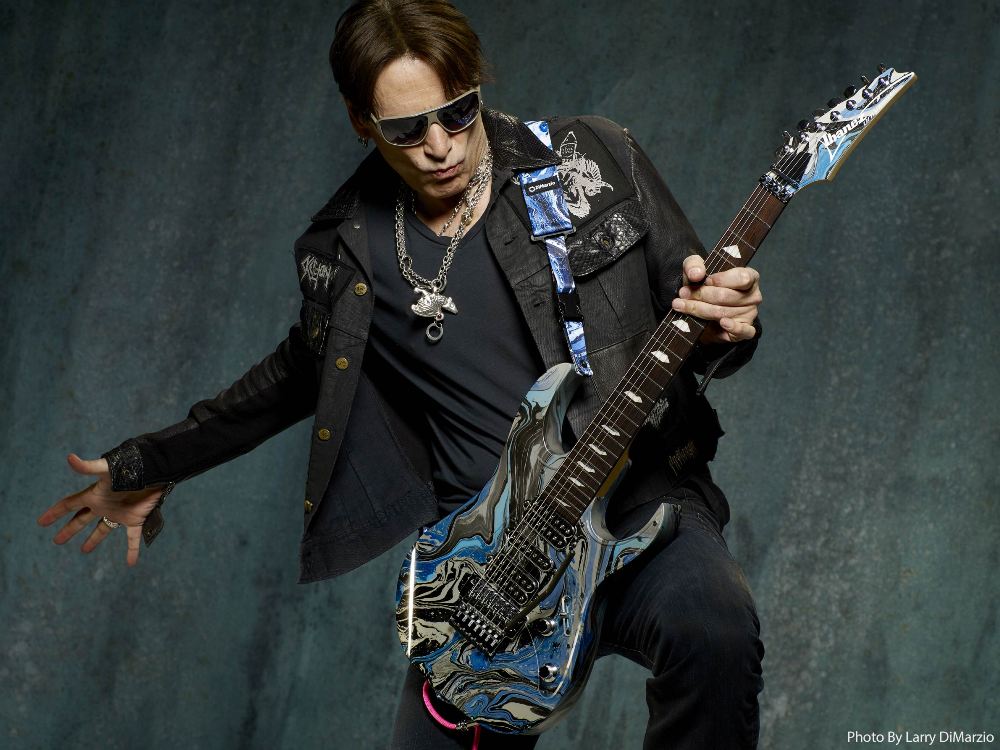
In the musical context of the 80s and 90s, a specific trend emerged with the development of the electric guitar: the appearance and popularization of the 7-string guitar. At the forefront of this movement were avant-garde artists such as Steve Vai, who, in collaboration with the company Ibanez, designed the Ibanez Universe, the very first mass-produced 7-string electric guitar. More than a mere redefinition of the electric guitar sound, this innovation broadened musical horizons across many genres.
Initially, bands of nu metal and alternative metal like Korn were among the first to grasp the potential of the seven-string guitar, using its ability to produce a heavier and deeper sound. This early adoption was a major turning point, expanding the instrument’s spectrum of use beyond traditional metal boundaries. Deftones took this experimentation even further, integrating the instrument into a unique blend of alternative metal, shoegaze, and nu-metal, thus showcasing the extraordinary versatile capabilities of the 7 and 8-string guitars in creating rich and complex sonic textures.

Jeff Loomis truly established new standards of technical performance on the seven-string guitar through his remarkable work with Nevermore and Arch Enemy, inspiring a whole new generation of guitarists. In this same vein of innovation, Dream Theater contributed to the adoption and popularization of the seven-string guitar in progressive metal.
Consequently, the band’s virtuoso guitarist, John Petrucci, used this instrument to push the boundaries of his compositions, incorporating complex solos and melodic riffs.
Their music, often noted for its thematic depth and technical complexity, was immeasurably enriched by the extended range and flexibility offered by seven-string guitars, thus establishing the band as a benchmark in the use of these instruments.
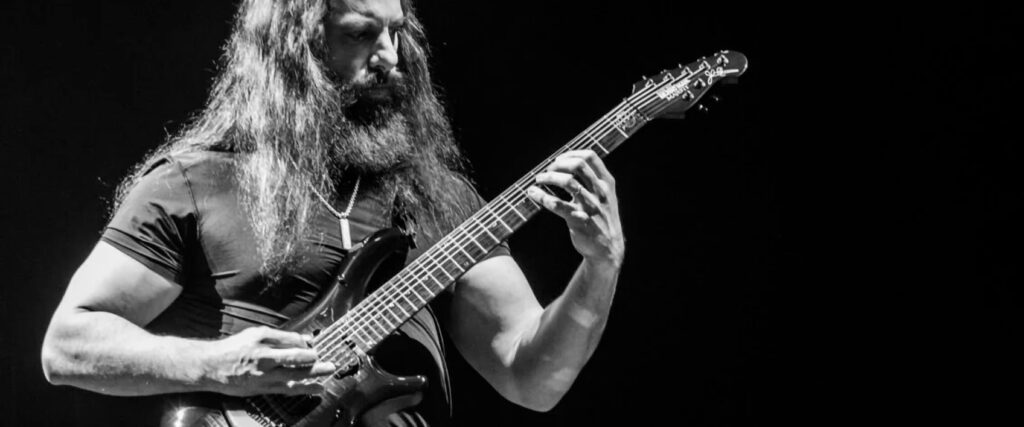
Djent bands such as Periphery and Monuments subsequently placed this instrument at the heart of their sound, leveraging its extended range to create heavy and technical riffs that became emblematic of the genre. Animals As Leaders, with Tosin Abasi at the helm, has since pushed things even further, exploring the limits of what 7 and 8-string guitars can achieve.
Their blend of rhythmic complexity, advanced tapping techniques, and jazz fusion influences has not only redefined the role of the guitar in progressive metal but has also encouraged many musicians from different styles to seek new creative pathways.
Adding to the 2020s landscape, metalcore artists such as Spiritbox, END, Crystal Lake, Make Them Suffer, Loathe, Volumes, and Bring Me The Horizon have also shown impressive diversity in the use of the 7-string guitar, each bringing a unique touch to their compositions.
But these 7 and 8-string guitars have gone well beyond metal, truly breaking genre barriers and finding followers in jazz, blues, up to the avant-garde. Musicians like Charlie Hunter or Ichika Nito have been able to adopt the 7-string guitar due to the unique ability of the instrument to blend bass lines and melodies.
This versatility has confirmed that 7 and 8-string guitars are more than just tools for extreme music but can be subtle and sophisticated instruments across a range of musical applications.
The pieces and tunings that define the sound of 7-string guitars

Dream Theater – The Mirror
Tuning: (B,E,A,D,G,B,E)

The 7-string guitar is central to the sound of Dream Theater, allowing John Petrucci to explore lower registers while retaining the ability to play complex solos and melodic riffs in higher registers. “The Mirror” leverages this range to deliver heavy and deep riffs that would be less accessible on a 6-string guitar, a major addition in terms of textures and dynamics of the piece.
This piece is available in full score in MySongBook.
Korn – Freak On The Leash
Tuning: (A,D,G,C,F,A,D)
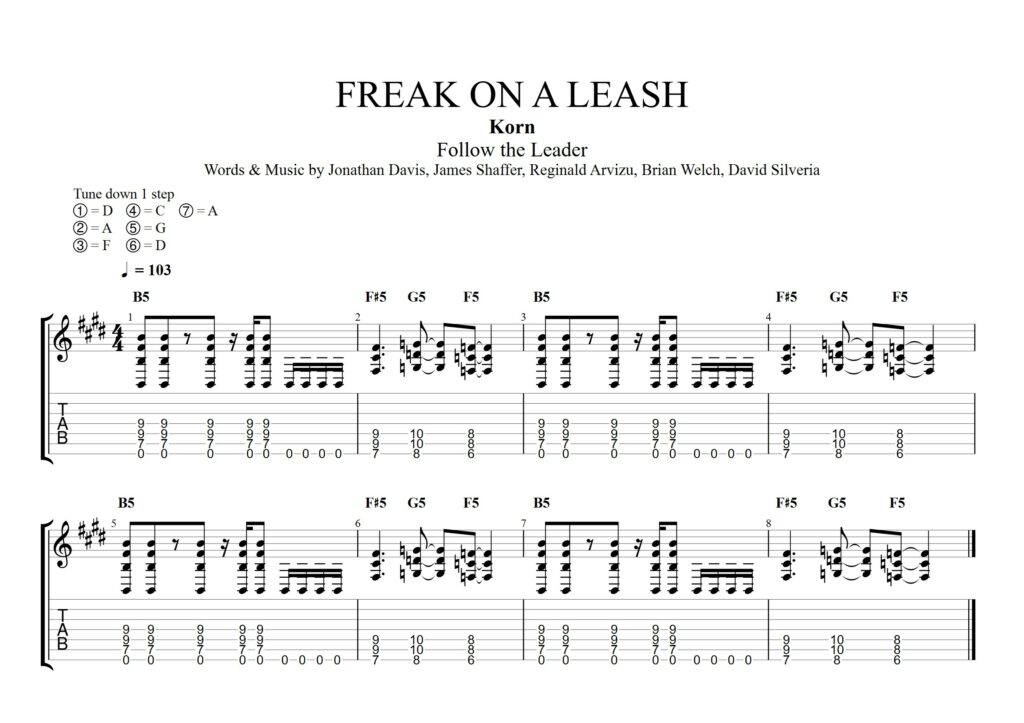
Korn is one of the pioneers in the use of the 7-string guitar in nu-metal, and “Freak On The Leash” perfectly illustrates the appeal of this approach. The low tuning and the use of the 7th string allow for particularly heavy and dark riffs, characteristic of Korn‘s sound and counterbalance with lead in the highs.
This piece is available in full score in MySongBook.
Muse – Supremacy
Tuning: (A,E,A,D,G,B,E)
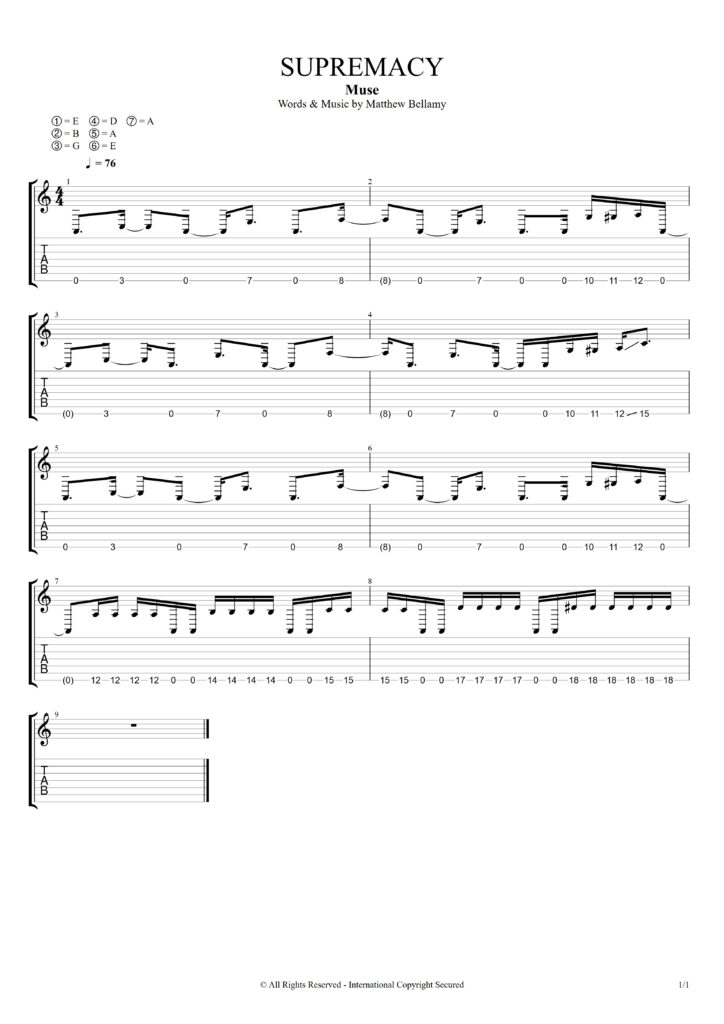
Although Muse does not traditionally use 7-string guitars, adding such a guitar to play “Supremacy” could enrich the guitar arrangements by offering the possibility to add bass lines or counterpoints in more orchestral sections, accompanying the heaviness of the sound density.
Slipknot – The Devil In I
Tuning: (A,E,A,D,G,B,E)
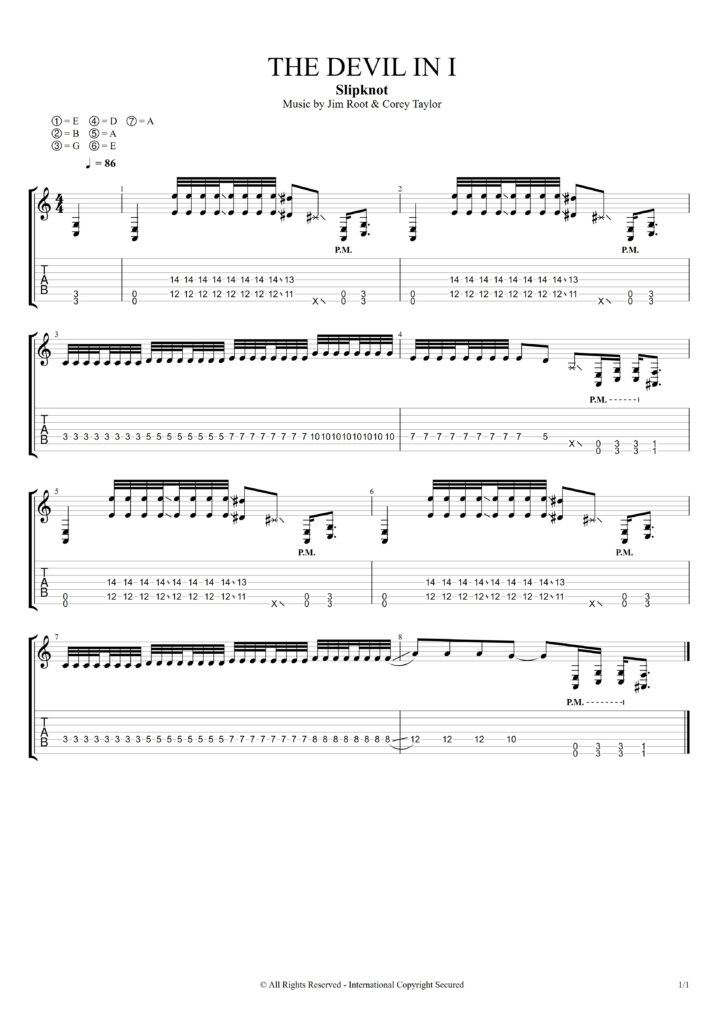
Slipknot frequently uses low tunings, and integrating a 7-string guitar for “The Devil In I” allows exploring even deeper and more menacing sonic textures, offering an extended sonic palette for aggressive riffs and breakdowns.
Meshuggah – Demiurge
Tuning: (F,Bb,Eb,Ab,Db,Gb,Bb,Eb)
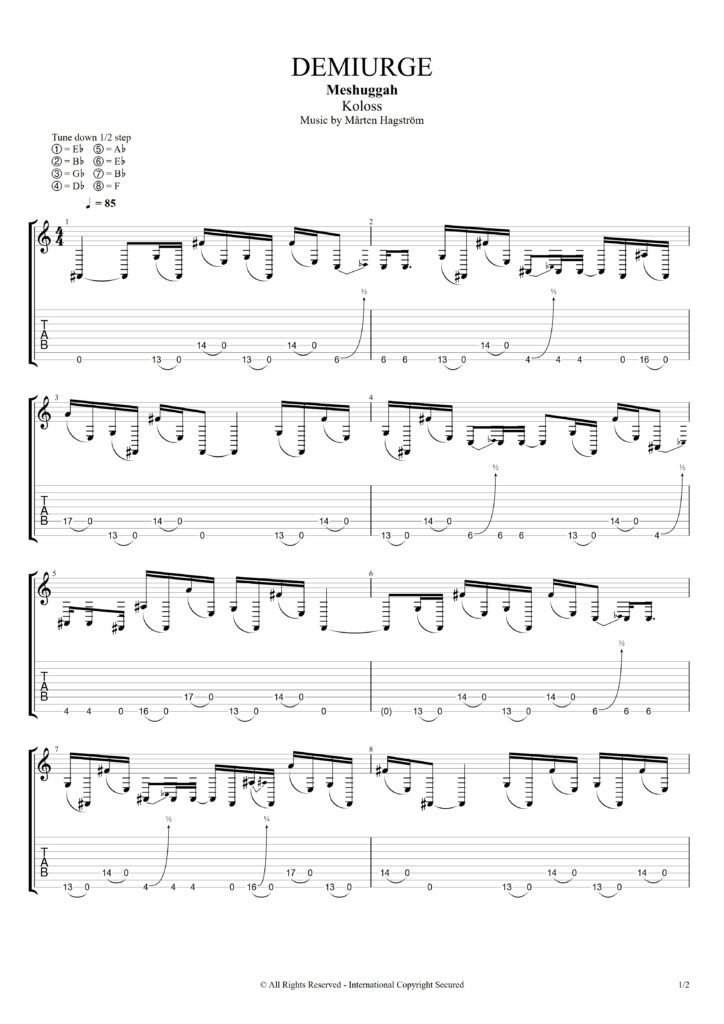
Meshuggah is synonymous with the use of 8-string guitars, but playing “Demiurge” on a 7-string guitar remains relevant to get closer to their distinctive sound. The polyrhythms and complex rhythmic patterns give a sonic depth that is fundamental to the djent style, the signature sound of Meshuggah.
Babymetal – Karate

Tuning: (B,E,A,D,G,B,E)
With a B standard tuning, using a 7-string guitar for “Karate” by Babymetal exploits the seventh string to build riffs on the first five semitones of the B string, allowing for very heavy and dissonant sounds, creating a striking contrast between metal and the major and joyful tones of J-pop. This approach enhances the power of the metal sections while preserving the flexibility needed to perform catchy melodies.
George Van Eps – Prelude To A Kiss
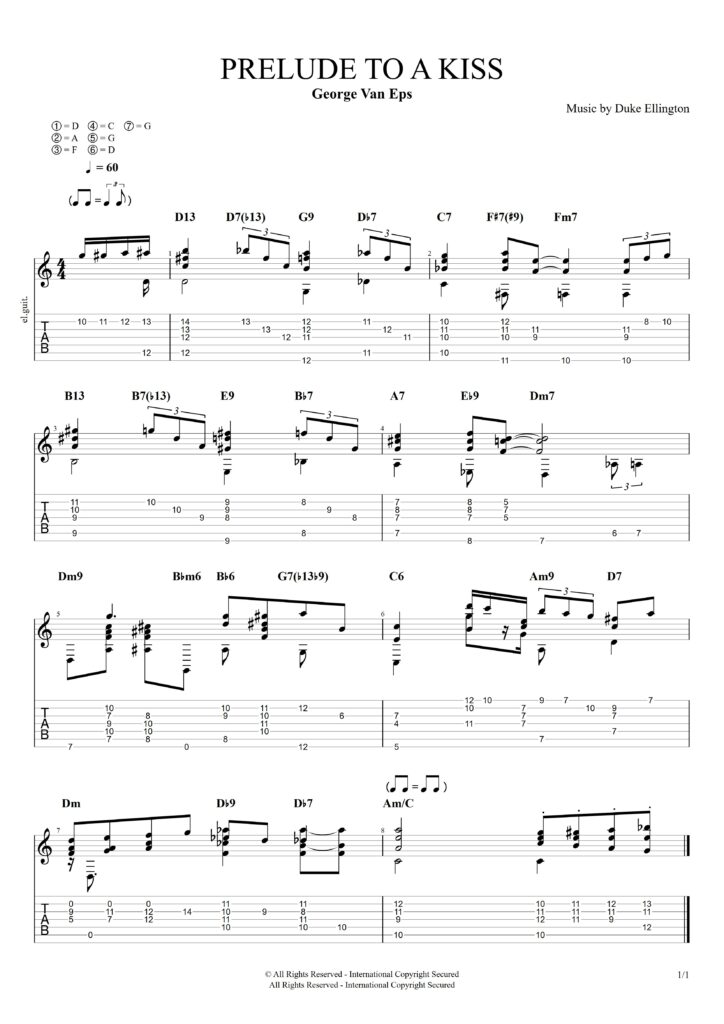
Tuning: (A,E,D,G,B,E,A)
Though less common in jazz, using a 7-string guitar for “Prelude To A Kiss” offers a new approach between harmony and accompaniment, allowing for deeper basses and enriching arrangements with a wider range of notes. This brings a new depth to the interpretation of jazz standards.
What are the specificities of the 7-string?
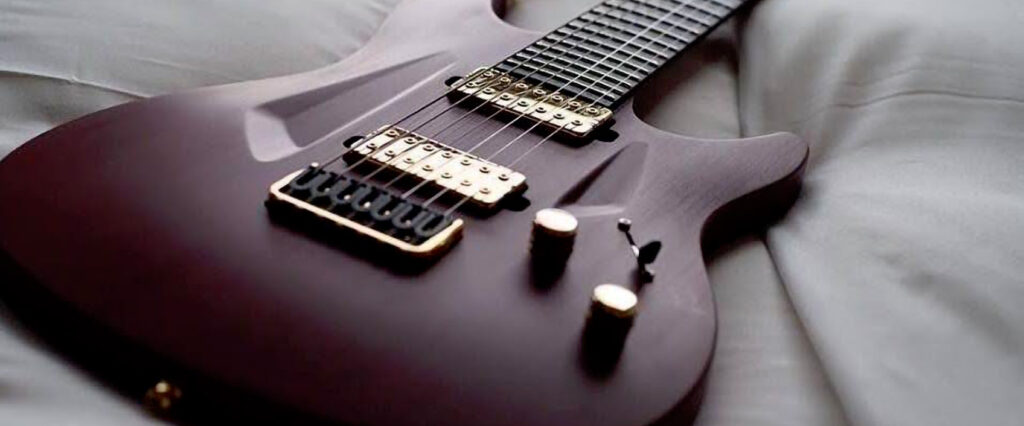
Electric guitars with 7 and 8 strings, with their robust design, feature a wider neck and an extended scale length to accommodate the additional strings and ensure optimal string tension similar to that of baritone guitars (generally between 27 and 25.5 inches). This configuration allows for clearer low notes, even with low tunings. Additionally, these guitars are often equipped with pickups specially designed to capture low frequencies.
A notable innovation in the design of some of these guitars is the adoption of the multiscale configuration (or fanned frets), where each string benefits from its own scale length. This results in several advantages, such as better low-end definition, more balanced string tension across the fretboard, and improved intonation.
These features make multiscale guitars particularly suited to modern techniques and demanding playing styles. While their appearance may seem strange at first, the ergonomics of the fanned frets naturally follow the angle of the fingers on the neck, providing a playing and tonal advantage.
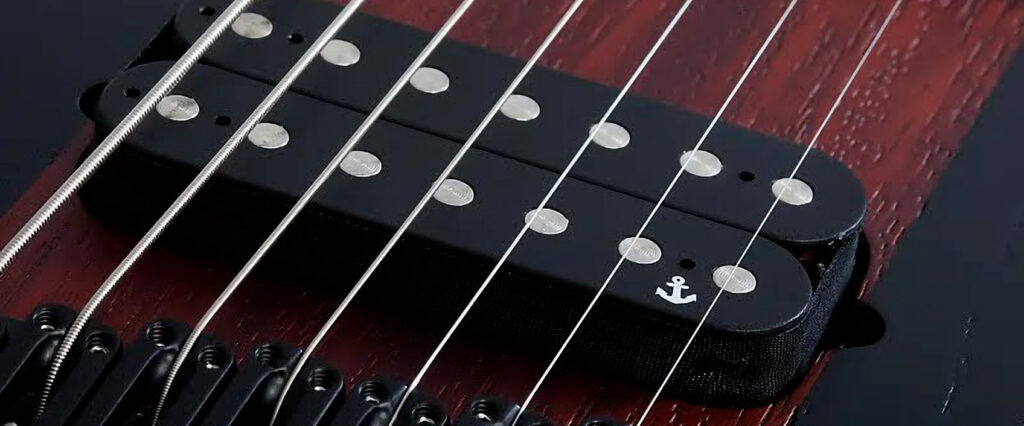
The seventh string adds a renewed sonic dimension to the instrument, offering depth and power that significantly enrich guitar playing. With this additional string, guitarists also have a wide range of tunings to explore, from Drop A (AEADGBE) to Drop G (GDGCFAD), through open C (GCGCGCE), and many others. Each tuning offers a new spectrum of creativity and musical expression, especially thanks to the standard B tuning (BEADGbE).
This configuration, though similar to the standard tuning of a six-string guitar, introduces a seventh string tuned a fourth lower than the low E, thus offering a low B. This feature facilitates a logical transition for guitarists accustomed to the six-string guitar, while expanding the available sonic spectrum, allowing for standard E playing or explorations into lower registers. Whether for innovative musical compositions, dense riffs, or complex chords.
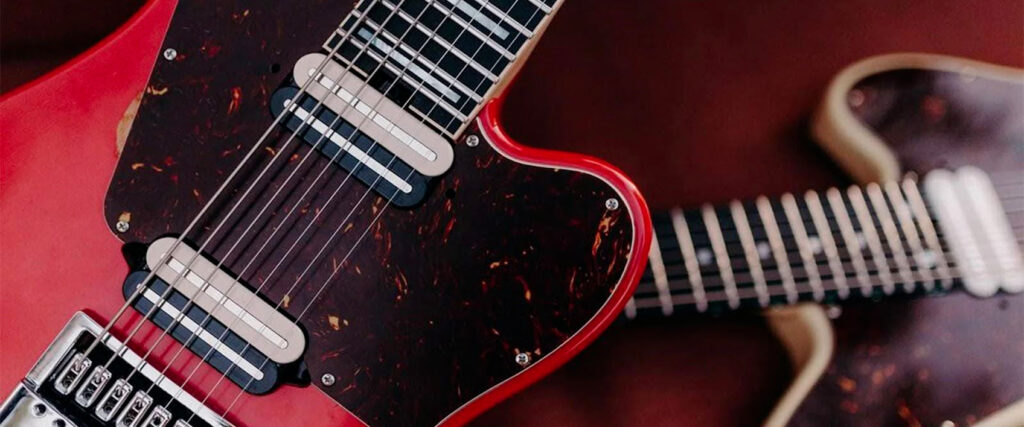
With this extension of the tonal range, guitarists can play richer and more complex chords, or simply add some low notes to a chord, thus enriching their compositions with unprecedented nuances and sonic textures.
The 7-string guitar enriches the musical landscape by offering an extended sonic palette, particularly valued in genres like metal, djent, and beyond. The addition of an extra low string allows musicians to explore lower registers without sacrificing the ability to play complex chords or detailed solos. Famous guitarists in progressive metal and djent genres have not only adapted this instrument to their specific needs but have also innovated in terms of playing techniques and sound. Its adoption across different musical styles testifies to its significant impact on broadening sonic horizons, offering musicians a valuable tool for their artistic expression.
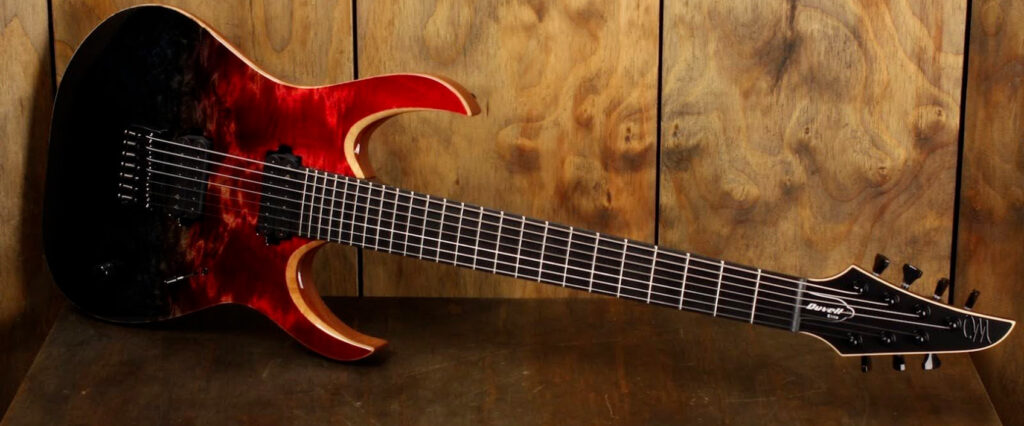
My recommendations
To conclude this article on the 7-string guitar, I offer a selection of pieces performed with this instrument, reflecting my personal favorites. This selection demonstrates the rich sonic possibilities afforded by the 7-string guitar. We hope these pieces will bring you as much listening pleasure as they have brought to their selection, making your playlists as enjoyable as reading this article.
Leave a comment
Your email address will not be published.



